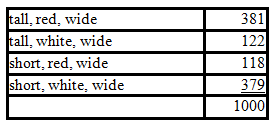Refer to Figure 31-6. The structures labeled 3 are involved in:
A. reproduction.
B. respiration.
C. excretion.
D. sensory pathways.
E. movement
C
You might also like to view...
Which of the following statements explains why restriction enzymes are not useful for genome-wide studies of genetic variation?
A. There is simply too much DNA that has to be cut in order to get any information. B. The differences in restriction sites are evened out when looking at the entire genome. C. Using restriction enzymes will only tell us differences in sequence variation in restriction sites. D. Restriction enzymes only recognize sequences found in genes. E. None of the answer options is correct.
If two or more of the genes are linked, what map distance separates them?
In peas, tall (T) is dominant to short (t), red flowers (R) is dominant to white flowers (r), and wide leaves (W) is dominant to narrow leaves (w). A tall plant that has red flowers and wide leaves is crossed to a short plant that has white flowers and narrow leaves. The resulting progeny are shown in the table.

A) 4 m.u.
B) 12 m.u.
C) 24 m.u.
D) 50 m.u.
E) None of the genes are linked to each other.
In the process of DNA replication, nucleotides are added as DNA is synthesized. Which best describes how it is determined what nucleotides are added?
A) The nucleotides are added to exactly match the sequence on the original strand. B) The free nucleotides that are in the greatest supply in the cell are added first. C) The nucleotides are added based on the complementary pairing of bases. D) The nucleotides are added randomly.
Which prokaryotic group is most closely related to eukaryotes
What will be an ideal response?